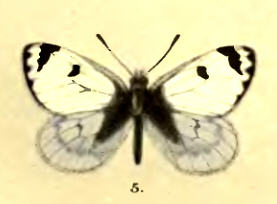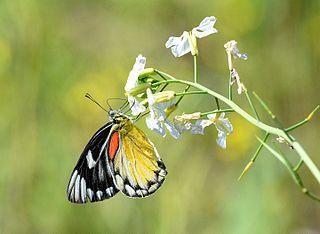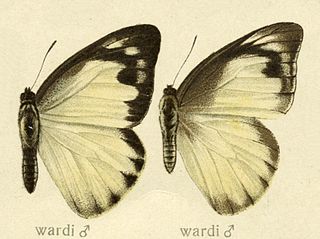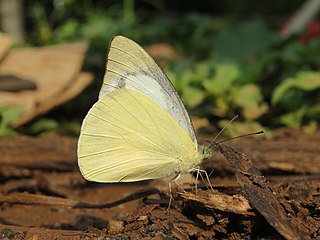
Cepora nerissa, the common gull, is a small to medium-sized butterfly of the family Pieridae, that is, the yellows and whites, which is native to Sri Lanka, India, China, southeast Asia, and Indonesia.

Baltia shawi, the Shaw's dwarf, is a small butterfly of the family Pieridae, that is, the yellows and whites. It is found at high altitudes in Central Asia.

Aporia nabellica, the dusky blackvein, is a mid-sized to large butterfly of the family Pieridae, that is, the yellows and whites, which is found in India and Pakistan in the western Himalayas: Kashmir to Naini Tal from 2,600 to 4,000 m. It has a wingspan of 6 to 7 cm.

Ixias marianne, the white orange tip, is a small butterfly of the family Pieridae, found in India and Sri Lanka.

Ixias pyrene, the yellow orange tip, is a small butterfly of the family Pieridae, that is, the yellows and whites, which is found in Sri Lanka, India and southeast Asia.

Colotis amata, the small salmon Arab, is a small butterfly of the family Pieridae, that is, the yellows and whites. It is found in Africa and Asia. Adults are fond of smaller flowers for nectar and often fly low along the ground in search of wildflowers.

Colotis vestalis, the white Arab, is a small butterfly of the family Pieridae, that is, the yellows and whites, which is found in India, Pakistan, Iran, Somalia, Ethiopia, Sudan, Kenya and Tanzania. It has a wingspan of 4–5 cm.

Colotis fausta, the large salmon Arab, is a small butterfly of the family Pieridae, that is, the yellows and whites, which is found in Israel, Syria, Turkey, Iran, Afghanistan, Turkmenistan, India, Arabia, Chad, Somalia and United Arab Emirates.

Colotis danae, the crimson tip or scarlet tip, is a small butterfly of the family Pieridae, that is, the yellows and whites. It is found in Asia and Africa.

Delias descombesi, the redspot Jezebel is a medium-sized butterfly of the family Pieridae, that is, the yellows and whites.

Delias pasithoe, the redbase Jezebel is a medium-sized butterfly of the family Pieridae, that is, the yellows and whites. The species is found in parts of South Asia and Southeast Asia. There has been some dispute for which species the specific name aglaja, used twice by Linnaeus in 1758, applies – the redbase Jezebel, or the dark green fritillary, a brush-footed butterfly. Here, Delias pasithoe is used for the redbase Jezebel, based on the replacement name proposed by Linnaeus himself.

Appias lalage, the spot puffin, is a small butterfly of the family Pieridae, that is, the yellows and whites, which is found in India, Indochina and Hainan.

Appias libythea, the striped albatross, is a small butterfly of the family Pieridae, that is, the yellows and whites, which is found in south and southeast Asia.

Appias wardii, the Indian albatross or Ward's albatross, is a small butterfly of the family Pieridae, that is, the yellows and whites, which is found in India.

Appias albina, the common albatross, is a small butterfly of the family Pieridae. It is found in south and southeast Asia to Australia.

Pontia callidice, the lofty Bath white or peak white, is a small butterfly of the yellows and whites family (Pieridae), which occurs in the Palearctic realm.

Jamides kankena, the glistening cerulean, is a small butterfly found in India that belongs to the lycaenids or blues family.

Curetis bulis, the bright sunbeam, is a species of butterfly belonging to the lycaenid family. It is found in Asia.

Melanitis phedima, the dark evening brown, is a species of butterfly found flying at dusk. The flight of this species is erratic. They are found in south and southeast Asia.

Charaxes nitebis, the green rajah, is a butterfly in the family Nymphalidae. It was described by William Chapman Hewitson in 1859. It is found in the Indomalayan realm.




















